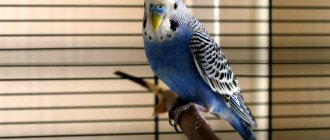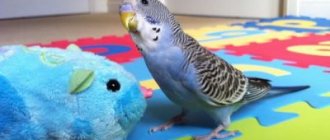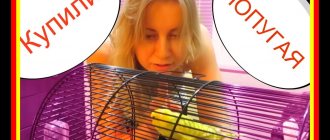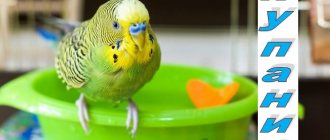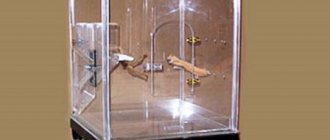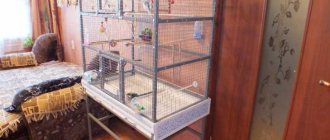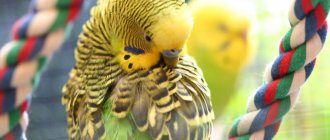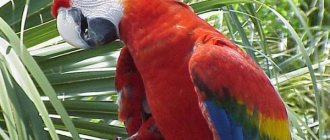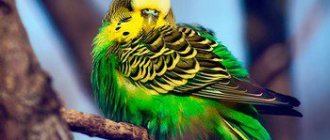First walk
The parrot should be released to fly after it gets used to you and its place of residence. Typically the adaptation period takes about two to three weeks. If during this time the bird has become comfortable, is active, eats well, shows interest in toys, and responds to its name, you can open the cage. The wavy will come out of it on its own, fly around to its heart's content and come back. There is no need to forcibly pull the bird out of the house or drive it back. This is fraught with severe fear and stress, even death.
How often to let a budgie out of its cage
If your pet lives in a large spacious cage and has the opportunity to spread its wings, then you can not let it out too often. But if the cage is cramped, then you should think about it. In any case, how often to let your budgie out of the cage is up to you, it all depends on how to train it. It would be good to let the bird fly 3-4 times a week, and if the cage is small, then every day.
Regarding whether a budgerigar needs to be released from its cage for a long time, it is worth noting that the free flight time should preferably last 3-4 hours. If you let your pet out all day, he may get used to freedom, and then he will rush out of the cage and scream loudly. To understand when you can let your budgie out of its cage, you need to take a closer look at the bird. As a rule, the parrot begins to chirp loudly and jump onto the cage.
In any case, the frequency of flights initially depends on your desire. Some owners buy a spacious cage and do not let the bird out at all. Some birds don’t even ask to be released, they are inactive. But others can be trained, and then they will demand to be released every day. Be attentive to your pet and you will understand what he needs.
Budgerigars are one of the most common pets in city apartments. This is explained, among other things, by the fact that caring for them is not very difficult, even compared to cats or dogs.
However, for owners who got a parrot for the first time, many of the nuances associated with keeping this bird raise questions. One of them concerns whether it is possible and necessary to let a parrot out of its cage to fly or not. You can get a complete and comprehensive answer to this question in this article.
Best time to fly
According to experts, it is optimal to release a parrot to fly in the afternoon, when most birds are in a calm, somewhat relaxed state.
About an hour before the walk, remove the feeder from the cage. An overfed pet will be inactive and will prefer to take a nap instead of flying. An important point - do not offer food outside the cage. Food should be strongly associated with home. An exception can be made for treats when you want to train your parrot to sit on your hand.
Should a parrot be released from its cage?
Some owners of budgies believe that a spacious cage is enough for their pet, from which it is not necessary to let it out.
Indeed, a spacious cage is most preferable for a bird, however, while in it, it experiences a lack of movement.
Even if you pay attention to your pet’s relatives living in the wild, you will notice that they can make fairly long, long-distance flights.
Physiologically, a domestic budgerigar is no different from one living in the wild. Therefore, flights are simply mandatory.
However, among some owners there is another extreme, when their pets have free access to flights, and the cage is never closed. Here, first of all, you should remember the safety of the parrot.
The fact is that many things in an apartment or house can be dangerous for a pet. Here are some recommendations on how to protect birds.
- Close all windows and vents. The greatest danger to a pet parrot is from open windows. The fact is that a bird can easily fly out of the apartment, but, for obvious reasons, will not be able to return. In this regard, you need to carefully ensure that while the parrot is walking around the apartment, all windows and other paths leading to the street are closed.
- Remove dangerous items. Piercing, cutting, heating, and switched-on electrical objects and equipment can be dangerous for a parrot. The bird may be injured if it comes into contact with them. In this regard, the owner needs to remove them from the pet’s reach. In addition, it is not allowed to have open electrical wiring in the room where the parrot will be.
- Avoid contact with indoor plants. A parrot may show an unhealthy interest in indoor plants. Some of them are poisonous to birds, and accordingly, their consumption is fatal for them. In this regard, it is necessary to remove indoor plants during walks until the parrot stops paying attention to them.
In addition, we should not forget about the microclimate of the room where the parrot is located. It should have an optimal temperature (from +15 to +25 degrees Celsius), humidity and a complete absence of drafts, which are extremely detrimental to the health of the bird.
Eliminate all hazards
The basic rule for flying a feathered friend around the apartment is to exclude all possible risk factors for the pet during the walk.
- Curtain the windows and mirrors so that the parrot does not harm itself by flying into an invisible barrier. Close the doors to other rooms, otherwise you will have to look for your pet around the apartment. In addition, he can sit on the door, and one of the household members will close it or it will slam shut from a draft. The parrot can be seriously or even fatally injured.
- Remove plants from the room. The bird will definitely want to taste them, which can lead to poisoning. Geranium, begonia, tradescantia, and many types of ivy are poisonous to parrots. A cactus in a pot can injure your pet.
- Make sure there are no gaps between pieces of furniture and walls where the bird could fall through. Wavys are curious, but their legs are not suitable for walking on smooth surfaces, so the pet runs the risk of falling into some kind of crevice.
- Water containers pose a potential hazard. During the walk, remove them from the room or cover them. Parrots love to swim, but are not always able to correctly assess the depth of the reservoir, risking choking.
- If you have other pets, remove them from the area where the wavy roams. Even a well-bred cat or dog is unlikely to be able to restrain its hunting instinct at the sight of a flying bird. It is not a fact that a winged pet will end up in the claws of a four-legged animal, but the consequences of such a “hunt” can be very destructive.
Why is it so important to let your parrot out of its cage?
If you do not let your feathered friend out of his house, this can cause health problems:
- depression;
- lack of appetite;
- dystrophy or excess weight;
- a number of diseases that are associated with disruption of the bird’s nervous system.
Moreover, if there is a lack of active movements, the wings of a budgerigar may atrophy, and your feathered friend will no longer be able to fly even around his cage, not to mention a spacious room. And this will be an upsetting moment for owners of wavy hair.
The most ideal option is to allow the budgie to fly around the apartment/house whenever he wants, that is, give him complete freedom of movement.
If you do not have such an opportunity, and there are still some restrictions, then in order to provide your pet with full-fledged active activity, experienced ornithologists recommend purchasing a cage, the size of which will allow the parrot to stretch its wings.
It is believed that a cage 0.6 m long, 0.4 m wide and 0.3 m high will be an excellent home for a budgerigar. A slightly larger cage will only please your feathered pet.
"Play corner" for birds
Get ready for the fact that the parrot itself can cause some damage to the interior - scratch furniture, wallpaper, decorative elements. In order to minimize damage, arrange a “play corner” for him. Find a large enough branch or snag, disinfect it and secure it to the wall. Hang a few ladders, rocking chairs, toys - and the parrot will find it much more interesting to spend time here rather than climbing cabinets or curtains.
Precautionary measures
When you decide to let your parrot out for a walk outside its cage, it will be best if you try to follow some recommendations from experienced ornithologists:
- If there are other pets in your house, by and large this applies to cats, then the room must be closed, otherwise the cat’s predatory instinct may kick in and its first flight may be fatal for it.
- When you decide that your pet can already be released from the cage, you should close all windows, vents, and doors. Thanks to this, it will be possible to avoid the wavy “escaping” into the street. And yes, do not forget to close the curtains, because the parrot may mistakenly try to fly out through a closed window, which will lead to injuries and bruises. And make sure that the parrot does not get entangled in curtains and curtains.
- If the house has an aquarium or terrarium and it is open, then it is best to cover it while the parrot walks through the open spaces of the room.
- Carefully inspect the room for sharp objects that are dangerous to the life of the bird. Remove everything that your feathered pet could get caught on and get hurt, close mirrors and cabinet doors. Make sure that objects cannot fall on your parrot.
- Ideally, the room in which your winged friend will fly should have no gaps, for example, between the closet and the wall. If there are any, then you can and even need to cover them with something so that the parrot does not fly into the cracks and get stuck there.
- When your bird is flying around the room, be careful with electrical appliances, many of them can cause irreparable harm to your pet's health. You should not let your parrot wander around the kitchen, and also hide those objects and things that you want to keep safe. After all, a bird can drop, break or smear something. Be prepared for the parrot to damage wallpaper, furniture and decor. Therefore, watch the bird’s flights very carefully and whenever it starts to do something wrong, carefully, without sudden movements, try to drive the bird away.
- Indoor plants pose a risk to your budgie's health, so make sure that he does not peck their leaves, flowers or stems under any circumstances.
Bringing the bird home
If your pet trusts you enough to sit on your hand, then lure him with a treat and take him to the cage. When there is no such close contact, you can return the bird home by playing on the feeling of hunger. If you remove the feeder from the cage before the walk, then after a couple of hours the pet will probably get hungry. Return the feeder to its place and add a fresh portion of grain - the bird will not keep you waiting. You can also lure your parrot to the cage using your favorite toy.
If the walk takes a long time, and the wavy does not want to return home, darken the room, while lighting the cage a little. The bird will unmistakably find its way to the house where there is food and water.
Care during adaptation days
You can help your feathered pet settle into a new territory by leaving it alone. Do not force your company on the bird. The first day of a budgie in a new home should be spent in a calm atmosphere. You cannot make noise near the cage, shout, or talk loudly. Refrain from loud music, stomping and slamming doors. Smoking is strictly prohibited in the room with the cage.
And one more thing: do not place flowers in close proximity to the bars of the “house”. The parrot is able to reach them and gnaw them thoroughly. The result of such “feeding” can be extremely sad.
Explain to children and household members that they should not pick up the parrot. He needs to be given time to get used to the new place. And someone else's hands are extra stress for the bird's body.
Place food at the bottom of the cage. If the water does not decrease in the drinking bowl, pour it into a saucer. And place it on the floor of the cage. Treat your pet to something tasty while talking to it. You just need to speak in a calm and even voice. Call the parrot by name and praise it. Wavys are very curious and sociable birds. If the owner, approaching the cage, pronounces the name of the bird every time, it will soon get used to it and begin to chirp in response.
How often should a wavy be released?
Flights have an extremely beneficial effect on the physical health and emotional state of the bird. Therefore, there are simply no restrictions on the maximum duration and their number per week. However, it should be borne in mind that they should not occur uncontrollably - the owner needs to control his pet, which is not always possible.
Of course, daily flights are highly desirable, but if the owner does not have enough time, then the cage should be opened at least 3-4 times a week.
In addition, it is important to choose the optimal flight time. It is believed that 2-3 hours of flight per day is enough for a parrot. However, in this case, you should still take into account the mood and desire of the bird itself.
Your pet should be released from its cage during the day or under artificial light. In the dark, it is safer for the parrot to be inside it.
The question often arises about how to release several pets from a cage - one at a time or separately. It should be understood here that if two or more parrots live in one cage, then the living space of the birds becomes more limited. That is why flights outside it should be given special attention. It is best to release the birds together.
What problems may arise
First, the bird adapts to the new environment. It is necessary to prepare all the necessary conditions for it so that the adaptation process takes place without stress for the bird. You definitely need to ask what the parrot eats.
Possible malfunctions in the digestive system will definitely not have a positive effect on the bird’s mood. The food can be scattered beforehand so that she can find it. The drinking bowl must be filled with clean water so that the parrot does not feel thirsty.
If the parrot is very small, then there is no need to buy closed drinking bowls and feeders. There are cases when a young chick climbed into closed feeders and died in them. This is the negative side of the bird’s adaptation to a new place. How to care for him in this case? You need to buy uncovered drinkers and uncovered feeders.
If the bird is afraid and seeks shelter, then you can cover one side of it with an opaque cloth. This will give the parrot a feeling of security. The adaptation period can last from one week to one month. These days, he may be especially frightened by the sharp sounds of the TV or the vacuum cleaner turned on.
When taming a winged creature to your home, you need to remember that only affection and care will make it feel at home. You also need to change water and food carefully, without unnecessary movements or noise. It depends only on the owner how the animal will behave: friendly or aggressive.
At first, the animal may even experience panos. In such a situation, you should definitely contact a veterinarian to identify the causes of irregular bowel movements.
The parrot is silent and does not tweet
Most often, the reason why a parrot does not tweet is loneliness. Insufficient attention received or lack of communication with him will lead to the bird withdrawing into its own world.
By nature, this creature is quite sociable. If he becomes severely depressed, the parrot may begin to pluck his feathers. When the owner does not attach importance to this and does not begin to take measures to cure the bird, death is possible.
A great idea would be to buy several pets at once. When a person has no time to pay attention to birds, they will play with each other and brighten up moments of absolute loneliness.
If your pet does not chirp, then perhaps he lacks some vitamins. Perhaps they suffer from a lack of sunlight and vitamins absorbed along with the sun's rays.
Retardation of movements for birds is especially typical in spring and autumn. To cure a bird of this, it is necessary to add vitamins and microelements to their food to help normalize the functioning of the body’s systems.
Running around the cage
By their temperament, animals are silent. The first day after purchase – even more so. They prefer contemplation of the world around them. Phlegmaticity is a trait that helps them stay in a cage for a long time, busy with their own affairs.
But if she starts to rush about, it means something frightened her or she lacks something in the environment of her house. In such situations, you need to add something from toys or change the appearance of the house inside. Immediately upon purchase, the house should have the following things:
- feeder (it should not be closed);
- drinking bowl (it should be easy to clean and it should also be easy to pour water into it quickly when it runs out;
- wooden perches. These should be small sticks attached to the walls of the cage. It is desirable that they be made from fruit trees. These are 2 - 3 pieces, each 1.5 cm in diameter;
- hanging rope;
- small mirror;
- swimsuit
The cage must be clean and comfortable. Before letting the animal in, it is necessary to thoroughly disinfect the house with soapy water. Then it must be wiped dry.
In addition, the house should be away from drafts, direct sunlight, heating devices, and equipment that causes vibration or makes a lot of noise.
Throwing around the cage can also be caused by the fact that the animal is getting used to the new conditions of its stay. In this case, you need to devote more time to your pet and make sure that it does not get bored.
Doesn't eat or drink
How to force a parrot to eat and drink if it doesn't want to? Just tame him. He was not yet accustomed to the unexpectedly changed environment. Poultry may also have problems with the gastrointestinal tract. To predict this problem, you need to monitor the animal's droppings.
In order for a bird to start eating and drinking in a new place, it needs to be accustomed to a change of environment. The animal's feeder must be full of food. In order for the parrot to eat regularly and properly, it is necessary to monitor the drinking bowl. Thirst will not have a positive effect on your budgie's appetite.
Liquid droppings
Liquid droppings are evidence that the animal is not eating well. If this happens, you need to consult a specialist to solve the problem. In some cases, the reason is poor food or lack of attention.
A bad mood is the first sign of developing depression, which can lead to the death of a bird. The necessary complex of minerals and trace elements added to the animal’s food will save it not only from irregular bowel movements, but also from a bad mood.
Collection of hatching eggs
It is important that the eggs that are placed under the hen are clean. To do this, they are collected immediately after laying and stored for no more than a week at room temperature - this period will not affect hatchability too much
However, over time, the quality of hatching eggs will decrease and the percentage of chicks produced will be lower.
It would not be amiss to say that hatching eggs should be of a typical size, shape and color for the breed. The average number of chicken eggs that a chicken of a meat-and-egg breed, for example New Hampshire, can successfully heat is 12-16 pieces. When breeding young of other bird species, the clutch size is reduced - you can lay up to 10 turkey eggs, about 7-8 duck eggs or 4-5 goose eggs.
When collecting eggs for incubation, they focus on a finite number - if you need to add a dozen, they collect just that many - you cannot add fresh eggs to a hen that is already incubating eggs. The hen will not stay long in the nest at the end of incubation and will leave it with her brood during the day, and the embryos that did not receive enough heat will die.
If you are not sure how many eggs the hen can heat, collect and add more, and the excess remaining uncovered around the edges can be removed during the first 24 hours.
The chicken decided to become a hen - the first stage
https://youtube.com/watch?v=-kcpgfckjeo
Inspection of eggs to monitor embryonic development
Already on the fifth day of incubation, you can determine whether there is an embryo in the egg or not. If you look at a bright light, for example, using a powerful flashlight, a void is clearly visible at the blunt end of the egg with the embryo, inside it is much darker than fresh, and you can even see the blood network on the yolk.
Then a small speck appears there - this is the future chicken. The further away, the larger the embryo, and therefore the darker the egg. The main indicator of the presence of an embryo is the contrast between the dark egg and the light air chamber, and usually such eggs are the majority in the clutch.
The egg is immediately visible - it is a cloudy egg with a splashing top; if you smell it, you can smell a slightly musty smell. If the embryo developed and then died, the blood ring is clearly visible in the egg. Such eggs should be thrown away, but if there is even the slightest doubt about the decision made, it is still better to return the egg to the chicken.
Ideally, to monitor embryonic development, you need to purchase an ovoscope, but it can be replaced with a lamp or flashlight. Inspections must be carried out in the absence of the hen, everything must be done quickly and very carefully so as not to catch a cold or break it.
How does mom feel?
During pregnancy, the expectant mother carefully prepares for the upcoming birth - reads books, watches videos, attends special preparatory courses, and packs things for the maternity hospital. But even with ideal psychological and physical preparation, childbirth turns out to be a difficult test for a woman, the first days are especially difficult.
After a natural birth, you will stay in the postpartum ward for 2 hours. This is due to the fact that sometimes early postpartum complications occur - increased blood pressure, uterine bleeding. To help your uterus contract better, an ice compress will be placed on your stomach.
After 2 hours you will be transferred to a room, the nurse will measure your blood pressure and temperature again. It is better for you to lie on your stomach for some time to facilitate the discharge of postpartum discharge and improve uterine contractions.
Possible problems after childbirth:
- Due to sphincter spasm, problems with urination occur. You may feel frequent urges, but no bowel movements occur. Or you may not feel the urge at all, the bladder empties suddenly. If you are unable to pee within 6 hours after birth, tell your midwife and she will insert a catheter.
- Childbirth rarely occurs without ruptures. Until the stitches have dissolved or been removed, you cannot sit or have bowel movements for 3 days.
- Try to lie down less. An active lifestyle promotes better uterine contractions. Restoring bowel and bladder function.
- After each visit to the toilet, wash yourself and change the pad.
Due to high physical and psycho-emotional stress, many women feel weak and drowsy after childbirth. Others, on the contrary, are very excited.
Feeding day-old young animals
The diet of small chickens up to 2-4 months is designed so that the growing body receives important nutritional elements. In addition to a clear distribution of the balance of carbohydrates, proteins, vitamins and minerals, it is necessary to strictly adhere to the feeding schedule. Day-old chicks are given crumbly porridge (mash) from hard-boiled, well-crushed yolk, millet cereal, finely crushed wheat grains, cleared of the top layer, diluted with a small amount of hot water. This feed is distributed to newly hatched livestock immediately after preparation (no later than 30 minutes).
The shells of grain crops: barley, oats, wheat contain a lot of fiber, which is difficult for early laying hens to digest. They must be cleaned during preparation.
In addition to the mash mixture, newborn laying hens will benefit from a finely ground egg sprinkled with corn or semolina (sprinkling is recommended so that pieces of yolks and whites do not stick to the fluff or paws of the chicks), and mixtures of ground grains:
- barley;
- corn;
- oats;
- peas
For mash, only medium-ground grain is suitable for day-old chicks. Too small particles of food enter their nostrils, causing irritation of the mucous membrane.
For chickens, you can also use ready-made feed, called “zero” or “starter”. They consist of crushed grains, amino acids, vegetable fats and a small amount of fishmeal.
Recipe for complete feed for young chickens of egg-cross breeds
| Ingredients | Age of young animals (days) | ||
| 1-30 | 31-90 | 91-150 | |
| Dry return | 1 | — | — |
| Fish flour | 3,9 | 4 | — |
| Corn | 17,4 | 10 | 10 |
| Wheat | 35 | 41 | 18 |
| Barley | 16 | 18 | 34 |
| Hydrolytic yeast | 4,5 | 4 | 2,9 |
| Meat and bone meal | 2,5 | 3 | 3 |
| Sunflower meal | 15 | 5,3 | 1 |
| Herbal meal | 3,5 | 5 | 8 |
| Ground shell | 1,2 | 1,5 | 1,3 |
| Table salt | — | 0,2 | 0,3 |
| Wheat bran | — | 8 | 10 |
| Bone flour | — | — | 1,5 |
| Millet | — | — | 10 |

